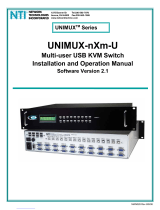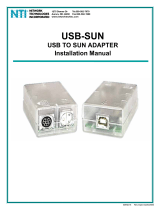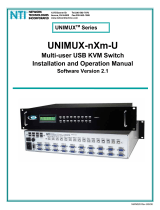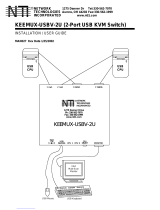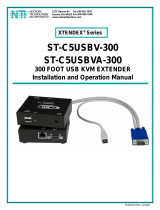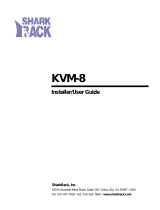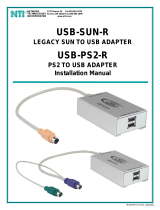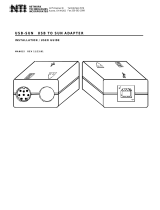Page is loading ...

MAN035 Rev Date 3/5/2007
UNIMUX-USBV-x
USB KVM Switch
Installation and Operation Manual
UNIMUX
TM
Series
NETWORK
TECHNOLOGIES
INCORPORATED
Tel:330-562-7070
Fax:330-562-1999
1275 Danner Dr
Aurora, OH 44202
www.networktechinc.com
NTI
R

i MAN035 Rev Date 3/5/2007
TRADEMARK
UNIMUX is a trademark of Network Technologies Inc in the U.S. and other countries
COPYRIGHT
Copyright © 2000-2007 by Network Technologies Inc. All rights reserved. No part of this publication may be reproduced, stored
in a retrieval system, or transmitted, in any form or by any means, electronic, mechanical, photocopying, recording, or otherwise,
without the prior written consent of Network Technologies Inc, 1275 Danner Drive, Aurora, Ohio 44202.
CHANGES
The material in this guide is for information only and is subject to change without notice. Network Technologies Inc reserves the
right to make changes in the product design without reservation and without notification to its users.
Application Note: This manual applies to UNIMUX-USBV-x switches made on or after October 1, 2004.
.

ii MAN035 Rev Date 3/5/2007
TABLE OF CONTENTS
INTRODUCTION.............................................................................................................................................................1
MATERIALS....................................................................................................................................................................1
DEFINITIONS..................................................................................................................................................................2
FEATURES AND FUNCTIONS.......................................................................................................................................3
RACKMOUNTING INSTRUCTIONS...............................................................................................................................4
To Mount to a Rack .....................................................................................................................................................4
INSTALLATION...............................................................................................................................................................5
Power-Up Sequence....................................................................................................................................................7
Limitations....................................................................................................................................................................7
USING THE UNIMUX USB KVM SWITCH.....................................................................................................................8
Front Panel Control......................................................................................................................................................8
Keyboard Control.........................................................................................................................................................8
MODES OF OPERATION...............................................................................................................................................9
Basic Command Mode ................................................................................................................................................9
Scan Mode................................................................................................................................................................9
Broadcast Mode......................................................................................................................................................10
Normal Mode ..........................................................................................................................................................10
No Sun Sleep Mode................................................................................................................................................10
Select Country Code...............................................................................................................................................10
Mice and Trackballs with MACs..............................................................................................................................11
OSD CONTROL............................................................................................................................................................12
Security Option..........................................................................................................................................................12
Enabling the Security Feature ................................................................................................................................12
User Login Mode.....................................................................................................................................................13
ADDITIONAL MODES AVAILABLE WITH SECURITY ................................................................................................13
Administration Mode...............................................................................................................................................13
Administrator Password..........................................................................................................................................14
User Name List.......................................................................................................................................................14
Edit User.................................................................................................................................................................15
Alternate Command Hot Key..................................................................................................................................16
USER ACCESS FUNCTIONS.......................................................................................................................................16
OSD Command Mode ............................................................................................................................................16
Broadcast Mode......................................................................................................................................................17
Scan Mode..............................................................................................................................................................18
Normal Mode ..........................................................................................................................................................18
Edit Mode................................................................................................................................................................18
Change Settings .....................................................................................................................................................19
Select Ports For Broadcast.....................................................................................................................................19
Select Ports For Scan.............................................................................................................................................20
Language Selection................................................................................................................................................20
MAC Ports Configuration........................................................................................................................................20
Search Mode...........................................................................................................................................................21
Maintenance Mode.................................................................................................................................................22
Help Mode...............................................................................................................................................................23
F3- Display Information...........................................................................................................................................23
RS232 CONTROL.........................................................................................................................................................24
RS232 Connections and Configuration.....................................................................................................................24
Remote Connection................................................................................................................................................24
Baud Rate...............................................................................................................................................................24
Unit Address and Loop Back..................................................................................................................................25
Command Protocol.................................................................................................................................................26
Matrix Switcher's Control Program For Windows 9X, NT, AND 2000.......................................................................27
SerTest- RS232 Interface Test Program...................................................................................................................27
Main Options...........................................................................................................................................................27
MOUSE CLICK EQUIVALENTS ...................................................................................................................................29
KEYBOARD FEATURES..............................................................................................................................................29
Keyboard-To-Computer Translation..........................................................................................................................29

iii MAN035 Rev Date 3/5/2007
Translation Capabilities ..........................................................................................................................................29
Translation Tables ..................................................................................................................................................29
International Sun Keyboards.....................................................................................................................................30
CASCADING.................................................................................................................................................................31
Configuration .............................................................................................................................................................31
Cascaded Installation ................................................................................................................................................31
Limitations..................................................................................................................................................................34
TROUBLESHOOTING..................................................................................................................................................34
WARRANTY INFORMATION........................................................................................................................................34
TABLE OF FIGURES
Figure 1- Secure rackmount ears to switch.....................................................................................................................4
Figure 2- Secure switch to a rack....................................................................................................................................4
Figure 3- Connect a VGA multi-scan monitor .................................................................................................................5
Figure 4- Connect the device(s)......................................................................................................................................5
Figure 5- Connect the AC line cord.................................................................................................................................6
Figure 6- Connect each CPU..........................................................................................................................................6
Figure 7- Compatible device combinations.....................................................................................................................7
Figure 8- Country Codes for international SUN keyboards...........................................................................................10
Figure 9- Administrator Login screen............................................................................................................................12
Figure 10- User Login screen........................................................................................................................................13
Figure 11- Administration Mode menu..........................................................................................................................13
Figure 12- Administrator password change ..................................................................................................................14
Figure 13- User Name List screen................................................................................................................................14
Figure 14- Edit the user access list...............................................................................................................................15
Figure 15- Command Mode screen ..............................................................................................................................16
Figure 16- More Command Mode features...................................................................................................................17
Figure 17- Edit Mode screen.........................................................................................................................................18
Figure 18- Change Settings menu................................................................................................................................19
Figure 19- Select ports for broadcasting.......................................................................................................................19
Figure 20- Select ports for scanning.............................................................................................................................20
Figure 21- Select the keyboard language.....................................................................................................................20
Figure 22- Configure Ports for MAC screen..................................................................................................................21
Figure 23- Search Mode screen....................................................................................................................................21
Figure 24- Maintenance Mode screen ..........................................................................................................................22
Figure 25- Information provided by the F3 command...................................................................................................23
Figure 26- RS232 dip-switches.....................................................................................................................................24
Figure 27- RS232 connection with Matrix-Y-1 cable.....................................................................................................25
Figure 28- Pinout of Matrix-Y-1 cable ...........................................................................................................................25
Figure 29- RS232 Communication Illustrated...............................................................................................................26
Figure 30- Keyboard Layouts....................................................................................................
....................................30
Figure 31- Connections for Cascading..........................................................................................................................31
Figure 32- Cascaded configuration with multi-user slaves ...........................................................................................32
Figure 33- Master-to-slave device cable connections- single-user switches................................................................33
Figure 34- Master to slave cable connections- multi-user switches..............................................................................33

NTI UNIMUX SERIES USB KVM SWITCH
1
INTRODUCTION
The UNIMUX-USBV-x (formerly referred to as KEEMUX-USBV-xU) USB KVM switch (UNIMUX) allows access to any Windows,
MAC, or SUN USB CPUs from one monitor, USB keyboard and USB mouse (up to 32 CPUs as a single switch or 512 CPUs when
cascaded). Internal microprocessor circuitry allows all USB CPUs to be booted simultaneously without keyboard error. Port
selection is accomplished by front panel push buttons or commands typed on the keyboard. Port lights and status LEDs
continuously update on the front panel.
Available Options
• Switch models are available in 60 or 50 Hz, and 110 or 220V.
• On Screen Display (OSD) Control feature will superimpose operating menus directly onto the monitor for security
administration and control. (Model UNIMUX-USBV-xO)
• RS232- Control the switch(s) from the serial port of any CPU with an RS232 port. (Model UNIMUX-USBV-xRS)
• Configuration is expandable by cascading switches (master must be UNIMUX-USBV-xO, slaves can be non-OSD)
Types of User Input Devices Supported:
• USB keyboard with Windows layout
• USB keyboard with SUN layout
• USB keyboard with MAC layout
• USB Mouse - (up to 3 buttons)
• USB IntelliMouse (scrollwheel)
• USB Hub
• Mouse-Trak trackball
• Logitech, Kensington and Microsoft Wheelmouse or Trackball on Mac CPUs with special drivers
• Logitech Cordless Elite Duo keyboard and mouse
• Crystal Vision keyboard with touchpad
• Gyration keyboard/mouse
• NTI USB-PS/2 Adapter
• NTI USB-SUN Adapter
• VGA, XGA, SVGA, and most DVI monitors (when used with NTI DVIF-15HDM adapter)
Types of CPUs Supported:
Any USB CPU supporting USB version 1.0 or above including:
• USB WINxx
• USB MAC
• USB SUN
MATERIALS
Materials supplied with this kit:
• NTI UNIMUX-USBV-x (2,4,8,12,16,24, or 32 ports) USB KVM Switch
•
120VAC or 240VAC at 50 or 60Hz-5VDC/2.0A AC Adapter
• Line cord, country specific
• Rack mount kit (4 and 8 port models only)
• CD with pdf file of this manual
Materials Not supplied but REQUIRED:
• A USBVEXT-xx-MM cable for each USB CPU being connected to the switch must be used for monitor, keyboard and mouse
interface.
• A REXT-SR-xx interface cable for each slave switch being attached to the master switch in a cascaded configuration (only
required if one or more slave switches was made prior to 10-1-04)
where:
xx is the length of the cable in feet
MM indicates male-to-male connector
Cables can be purchased from Network Technologies Inc by calling (800) 742-8324 (800-RGB-TECH) in the US and Canada or
(330) 562-7070 (worldwide).

NTI UNIMUX SERIES USB KVM SWITCH
2
DEFINITIONS
• USB Composite
Device
A USB device that contains multiple endpoints each representing input devices that cannot be separated
(i.e. a keyboard with a built-in mouse)
• USB Hub
A USB device that allows one or more USB input devices to plug in to the USB. The hub has exactly one
upstream port with one or more downstream ports which input devices connect to
• CPU
Enclosure that contains the operating system and processor (i.e. Sun with SPARCstation5, Windows 95
with Pentium II)
• Input Device
Keyboard or Mouse
• System
One or more CPUs connected to one or more switches controlled by one or more input devices

NTI UNIMUX SERIES USB KVM SWITCH
3
FEATURES AND FUNCTIONS
1. CPU Status LEDs- for visual indication of connection between the user and a specific CPU.
2. Daisy In/Out - for attaching interface cables (REXT-SR-xx) between slave switches and the master switch (only necessary
when connected to UNIMUX-USBV-xO switches made prior to 9/22/04)
3. RS232- (optional) Dip switches for configuring switch address when RS232 is used
4. Cascade- Dipswitches for configuring cascaded switches (only necessary when connected to switches made prior to 9/22/04)
5. CPU Select Switches- push to manually switch to a specific CPU or change the switch operating mode
6. Mode Status LEDs- for visual indication of switch operating mode
7. IEC Connector- for attachment of country-specific power cord
8. Power Switch- to power up or power down the UNIMUX
9. RS232-(optional) 9DB male connector- for attachment of RS232 control cable
10. CPU x- USB type B female connector-for connection of USB device cable from CPU(s)
11. DEVICES- USB type A female connector- for connection of user USB device(s)
12. VIDEO-x- 15HD female connectors- for connecting video cables from CPUs
13. MONITOR- 15HD female connector- for connection of the user video monitor
F E A T U R E S A N D F U N C T I O N S
1 8
1
8
C a s c a d eR S 2 3 2
O n
O f f
N T I
R
N e t w o r k T e c h n o l o g i e s I n c
S c a n
C o m m a n dB r o a d c a s t
1 2 3 4
U N I M U X
T M
5 6 7 8
D a i s y
I n
D a i s y
O u t
1
2 3 4 5 6
F r o n t V i e w o f U N I M U X - U S B V - 8
M O N I T O R
U S B D E V I C E S
C P U 4
C P U 3
C P U 2 C P U 1
C P U 8
C P U 7
C P U 6 C P U 5
8 4
7 3 6 2 5 1
V I D E OV I D E O
R
S
2
3
2
N E T W O R K T E C H N O L O G I E S
I N C
T e l : 3 3 0 - 5 6 2 - 7 0 7 01 2 7 5 D a n n e r D r , A u r o r a , O H 4 4 2 0 2 w w w . n t i 1 . c o m
7 8
9
1 0
1 1 1 2
1 3
R e a r V i e w o f U N I M U X - U S B V - 8

NTI UNIMUX SERIES USB KVM SWITCH
4
RACKMOUNTING INSTRUCTIONS
This NTI switch was designed to be mounted to a rack or to set on a desktop. It includes rackmount ears to make attachment to
a rack easy, and rubber feet to be applied to the bottom of the case if it will instead sit on a flat surface. If this will sit on a flat
surface, simply apply the rubber feet to the bottom of the case in each of the 4 corners.
To Mount to a Rack
1. Attach the ears to the switch using the 6-32x3/16" flat Phillips-head screws (6) provided as shown in the illustration below.
The holes in the ears should line up with pre-threaded holes in the sides of the NTI switch. Tighten the screws securely.
Figure 1- Secure rackmount ears to switch
2. Install 4 captive nuts (not provided) to the rack in locations that line up with the holes in the mounting ear on the NTI switch.
3. Secure the NTI switch to the rack using four 3/16" diameter screws (not provided). Each screw should be of sufficient length
to go completely through the NTI mounting ear, rack frame and fully engage all threads in the captive nut. Be sure to
tighten all mounting screws securely.
4. Attach all cables securely to the switch and where necessary supply adequate means of strain relief for cables.
Figure 2- Secure switch to a rack
6 - 3 2 x 3 / 1 6 "
F l a t H e a d
S c r e w s
( P r o v i d e d )
R a c k m o u n t E a r
N T I S w i t c h
F r o n t o f S w i t c h
C a p t i v e N u t s
3 / 1 6 " D i a m e t e r S c r e w s
R a c k
( n o t p r o v i d e d )
( n o t p r o v i d e d )
N T I S w i t c h

NTI UNIMUX SERIES USB KVM SWITCH
5
INSTALLATION
1. It is not necessary to turn the CPUs or monitors OFF during this installation.
2. Connect the cable from a VGA multi-scan monitor to the 15HD connector labeled “MONITOR” on the UNIMUX (See Fig. 3
below.)
Figure 3- Connect a VGA multi-scan monitor
3. Connect the male USB type A connector on the keyboard cable to either one of the two USB type A female connectors
labeled "DEVICES" on the rear panel of the UNIMUX.
4. Connect the male USB type A connector on the mouse cable to the remaining USB type A female connector labeled
"DEVICES".
Figure 4- Connect the device(s)
V G A
M u l t i - S c a n
M o n i t o r
1 5 H D M a l e
V i d e o C o n n e c t o r
1 5 H D F e m a l e
V i d e o C o n n e c t o r
R e a r V i e w o f U N I M U X - U S B V - 8
M O N I T O R
U S B D E V I C E S
C P U 4
C P U 3
C P U 2 C P U 1
C P U 8
C P U 7
C P U 6 C P U 5
8 4
7 3 6 2 5 1
V I D E OV I D E O
R
S
2
3
2
N E T W O R K T E C H N O L O G I E S
I N C
T e l : 3 3 0 - 5 6 2 - 7 0 7 01 2 7 5 D a n n e r D r , A u r o r a , O H 4 4 2 0 2 w w w . n t i 1 . c o m
U S B K e y b o a r d
U S B
M o u s e
U S B T y p e A
M a l e C o n n e c t o r s
U S B T y p e A M a l e
R e a r V i e w o f U N I M U X - U S B V - 8
M O N I T O R
U S B D E V I C E S
C P U 4
C P U 3
C P U 2 C P U 1
C P U 8
C P U 7
C P U 6 C P U 5
8 4
7 3 6 2 5 1
V I D E OV I D E O
R
S
2
3
2
N E T W O R K T E C H N O L O G I E S
I N C
T e l : 3 3 0 - 5 6 2 - 7 0 7 01 2 7 5 D a n n e r D r , A u r o r a , O H 4 4 2 0 2 w w w . n t i 1 . c o m
U S B T y p e A F e m a l e

NTI UNIMUX SERIES USB KVM SWITCH
6
5. When cascading switches, follow the instruction on page 29 for "Cascading".
6. Connect the AC line cord to the UNIMUX. (See Fig. 5 below.)
Figure 5- Connect the AC line cord
7. Connect each CPU to the USB switch using a USBVEXT-xx-MM video and input device interface cable – REQUIRED
(not supplied). (See Fig. 6 below.)
8. Group the input device and monitor interface cables from each CPU, making sure that cables from the first CPU are
connected to the UNIMUX at connectors CPU 1 and VIDEO 1. Cables from the second CPU should
connect to CPU 2 and VIDEO 2 connectors...etc.
Figure 6- Connect each CPU
M O N I T O R
U S B D E V I C E S
C P U 4
C P U 3
C P U 2 C P U 1
C P U 8
C P U 7
C P U 6 C P U 5
8 4
7 3 6 2 5 1
V I D E OV I D E O
R
S
2
3
2
N E T W O R K T E C H N O L O G I E S
I N C
T e l : 3 3 0 - 5 6 2 - 7 0 7 01 2 7 5 D a n n e r D r , A u r o r a , O H 4 4 2 0 2 w w w . n t i 1 . c o m
R e a r V i e w o f U N I M U X - U S B V - 8
I E C P o w e r c o r d
MONITOR 1
MONITOR 2
MONITOR 3
MONITOR 4
USER 1USER 2
USER 3USER 4
R
S
2
3
2
NTI
R
CPU 16
MONITOR 1
MONITOR 2
MONITOR 3
MONITOR 4
USER 1USER 2
USER 3USER 4
R
S
2
3
2
NTI
R
CPU 16
SLAVE #2 UNIMUX 4X16 SLAVE #1 UNIMUX 4X16
USBVEXT-
xx
-MM
USBVEXT-
xx
-MM
CONNECT MASTER CPU PORT 1
TO ONE USER PORT ON SLAVE1
CONNECT MASTER CPU PORT 2
ONE USER PORT ON SLAVE2
MONITOR
USB DEVICES
CPU 4 CPU 3 CPU 2 CPU 1
CPU 8 CPU 7 CPU 6 CPU 5
8 4 7 3 6 2 5 1
VIDEOVIDEO
R
S
2
3
2
NETWORK TECHNOLOGIES INC Tel:330-562-70701275 Danner Dr, Aurora, OH 44202 www.nti1.com
REAR VIEW OF MASTER (UNIMUX-USBV-8O)

NTI UNIMUX SERIES USB KVM SWITCH
7
Power-Up Sequence
• The UNIMUX can be powered at any time.
• The CPUs can be powered at any time although if a CPU needs a keyboard and/or mouse at power-ON it should be powered
after connecting to and powering-ON the UNIMUX.
• USB input devices (keyboard and mouse) can be hot plugged to and from the UNIMUX at any time.
Immediately after powering ON the UNIMUX, the following splash screen will appear on the monitor if the OSD option is built into
the switch:
If the security option is enabled (see page 12 for details on the
"Security Option"), when the UNIMUX is powered up the user will
be prompted for a username and password to continue. If the
security option is not enabled the monitor will display the desktop
image for the connected CPU and the user can continue with
normal operation of the connected CPU.
Limitations
• Only USB input device or hub cables can be connected to the UNIMUX at the USB Type A female ports labeled "DEVICES".
(See Features and Functions on page 3, item 11.)
• A USB hub (single or multi-port) can be used provided only USB input devices are plugged into it.
• Only a USB Windows or SUN keyboard or USB mouse may be connected to the USB port on a USB MAC keyboard
• A maximum of 8 input devices may be connected to the UNIMUX either directly or through hubs.
See Fig. 7 for some examples of input device combinations that can be used with the UNIMUX.
Figure 7- Compatible device combinations
U S B W i n d o w s K e y b o a r d
U S B
M o u s e
U S B T y p e A
M a l e C o n n e c t o r s
U S B M A C K e y b o a r d
U S B
M o u s e
U S B
M o u s e
U S B
M o u s e
U S B W i n d o w s K e y b o a r d
U S B W i n d o w s K e y b o a r d
U S B M A C K e y b o a r d
U S B M A C K e y b o a r d
2 U S B h u b s i n s e r i e s ( D a i s y - C h a i n e d )
T y p i c a l I n s t a l l a t i o n - 1 K e y b o a r d , 1 M o u s e
O p t i o n a l - M u l t i p l e k e y b o a r d s a n d m i c e
O p t i o n a l - M A C U S B k e y b o a r d a n d m o u s e
U S B
H u b

NTI UNIMUX SERIES USB KVM SWITCH
8
USING THE UNIMUX USB KVM SWITCH
Once the UNIMUX is properly connected, the UNIMUX will enable a connection to be made between the CPUs attached to its
VIDEO and CPU ports and the monitor and input devices attached to the MONITOR and DEVICES ports. The LEDs on the
control panel of the UNIMUX will illuminate depending on which port (and corresponding CPU) is being connected to the monitor
and input devices.
The UNIMUX can be controlled by three methods:
• front control panel using touch-switches and LEDs
• keyboard control through Command Mode
• mouse clicks from within some menus of OSD Command Mode (optional).
Front Panel Control
There is a touch-switch and LED on the front panel of the UNIMUX for each CPU the switch will connect the monitor and
input devices to. Pressing any touch-switch on the front panel of the UNIMUX will connect the corresponding CPU to the monitor
and input devices.
Holding down any front panel touch-switch for more than 2 seconds will cause the UNIMUX to cycle through all modes of
operation including COMMAND, BROADCAST, SCAN, and NORMAL (described in "Basic Command Mode" on page 8 and in
"User Access Functions" starting on page 15). The three MODE LEDs on the front panel indicate which mode is selected.
Release the touch-switch when the LEDs indicate the desired mode. When no mode LEDs are illuminated the user is in Normal
Mode controlling directly the CPU to which the user is connected through the UNIMUX.
Keyboard Control
Keyboard control of the UNIMUX can be achieved using either of two methods:
• Basic Command Mode- operated strictly by using keyboard commands as instructed below. Basic Command Mode
is only applicable if the OSD option is not built into the switch.
• OSD Command Mode (optional)- operated using the keyboard and mouse in conjunction with OSD menus superimposed
onto the monitor. If OSD is built in, use the menus as instructed on page 12.
By pressing <Ctrl> + < ` > (accent key), the user can enter Command Mode (either Basic, or OSD). Once in Command
Mode, typing a series of commands will cause the UNIMUX to connect the user to any one CPU connected to the switch.
Pressing the <Esc> key will exit Command Mode.

NTI UNIMUX SERIES USB KVM SWITCH
9
MODES OF OPERATION
Basic Command Mode
In order to control the UNIMUX with the keyboard connected, Command Mode must be enabled. To enter Command Mode from
the keyboard:
Press
NOTE: IF THE OSD FEATURE HAS BEEN INSTALLED, PROCEED DIRECTLY TO
“OPTIONAL OSD CONTROL” ON PAGE 12. If not, continue on this page.
When the COMMAND LED is illuminated, all 3 status lights on the keyboard will illuminate (if they aren't already due to caps lock,
scroll lock, and/or num lock) to indicate that Command Mode is enabled and the following functions are available:
Basic Command Functions
Function: Keystroke:
Increment Port
Decrement Port
Toggle Scan Mode
ON and OFF
Toggle Broadcast Mode
ON and OFF
Sets scan time-out
period for each port.
Selects a specific
port
Configure port to connect
To a MAC CPU
Configure port to connect
To a WINDOWS or SUN
CPU
Exit Command Mode
Scan Mode
When in Scan Mode the switch scans to each port with a CPU powered-ON. (The SCAN LED on the front panel will illuminate and
remain ON while in Scan Mode. ) The port with the CPU powered-ON remains active while in use until it becomes idle for the
configured dwell time (default time-out period is 5 seconds) before switching to the next powered-ON CPU port. See Command
Mode section above for configuring the scan dwell time.
Note: The keyboard and mouse must remain idle for the full scan dwell time before the switch selects the next active
port.
`
+
Ctrl
~
(ACCENT
KEY)
`
P
-
-
(Pxx would be P01, P02, etc.)
(0-9)
x
(0-9)
x
CHORDED SEQUENCE- PRESS CONSECUTIVELY
AND KEEP KEYS PRESSED UNTIL ALL ARE PRESSED.
+
-
PRESS CONSECUTIVELY
or
PRESS EITHER KEY
KEY SYMBOLS LEGEND:
I
(select the next higher port
ex. 05 06)
or
D
or
(select the next lower port
ex. 02 01)
Esc
FYI: The user must exit Command Mode to type to a CPU.
To exit Command Mode, either hold down any touch-switch on the
front panel for more than 2 seconds, OR press <ESC> on the
keyboard.
S
(The SCAN Mode LED will
also toggle ON and OFF)
T
-
-
(xxx from 002 to 255. ie. T002
would set the time-out period
for 2 seconds)
-
(0-2)
x
(0-9)
x
(0-9)
x
B
(The Broadcast Mode LED
will toggle ON and OFF.)
+
M
x
(xx= 01-32 <M> + <0> + <1> will enable function on Port 1
<M> + <3> + <2> will enable function on Port 32. Keyboard
LED's will flash once to confirm command. )
+
x
+
W
x
(xx= 01-32 <W> + <0> + <1> will disable function on Port 1
<W> + <3> + <2> will disable function on Port 32. Keyboard
LED's will flash once to confirm command. )
x
+

NTI UNIMUX SERIES USB KVM SWITCH
10
Broadcast Mode
To activate Broadcast Mode press <Ctrl> + <B> from the Command Mode menu.
Broadcast Mode enables the user to type characters to more computers simultaneously. From the Change Settings menu (see
page 18) the user can edit the list of ports that receive data in Broadcast Mode. A port doesn’t receive broadcast data if one of the
following conditions is true:
- the port is not in the Broadcast Mode list
- Security Mode is enabled and the user does not have access rights to the port
NOTE: The user must type somewhat slowly when in Broadcast Mode (less than 20 wpm) and cannot use the
<Backspace> key.
Normal Mode
When all of the UNIMUX mode LEDs are OFF the user is in Normal Mode, controlling the CPU to which the user is connected
through the UNIMUX.
No Sun Sleep Mode
PLEASE NOTE: It is necessary to configure a Sun CPU (most versions) such that the Sleep Mode is not enabled. If the
Sun CPU goes into Sleep Mode either automatically or manually, the user must reboot the Sun CPU in order to resume
use of the Sun CPU.
To disable the Sleep Mode, perform the following steps:
1. Select "Power Manager"
2. Look for "Device Idle Time Before Power Saving Starts"
3. Select "Always ON"
4. Look for "Override Device Idle Time For:"
5. Make sure neither "Monitors" nor "Disks" are selected.
Select Country Code
It is possible to configure the UNIMUX to emulate a specific international Sun keyboard regardless of what actual keyboard is
connected. This is recommended when the CPU needs the layout code (i.e. a SUN CPU) and the keyboard doesn't have an
explicit layout code (i.e. some Windows keyboards). To do this, manually set the UNIMUX to indicate the international keyboard
identification number to the CPU using the following procedure;
1. Connect the keyboard to be used to the UNIMUX
2. Enter Command Mode
3. Type Lxx, where xx is the number from the list below that corresponds to the desired country code
4. Exit Command Mode
5. Reboot the CPU connected to the UNIMUX
Country Codes
00 Auto Detect 13 International (ISO) 26 Swedish
01 Arabic 14 Italian 27 Swiss/French
02 Belgian 15 Japan (Katakana) 28 Swiss/German
03 Canadian-
Bilingual
16 Korean 29 Switzerland
04 Canadian-French 17 Latin American 30 Taiwan
05 Czech Republic 18 Netherlands/Dutch 31 Turkish
06 Danish 19 Norwegian 32 UK
07 Finnish 20 Persian (Farsi) 33 US
08 French 21 Poland 34 Yugoslavia
09 German 22 Portuguese
10 Greek 23 Russia
11 Hebrew 24 Slovakia
12 Hungary 25 Spanish
Figure 8- Country Codes for international SUN keyboards
For more on international SUN keyboards, see page 29.

NTI UNIMUX SERIES USB KVM SWITCH
11
Mice and Trackballs with MACs
The UNIMUX can be configured to enable full functionality between mice and trackballs having two or more buttons and USB
MAC CPUs. By default, the ports on the UNIMUX are configured for use with WINDOWS and SUN CPUs and have no special
translation for using multi-function mice and trackballs when a MAC CPU is connected. Using the commands <M> + <x> + <x>
(xx = port number), or <W> + <x> + <x> in Command Mode (page 8), either enable or disable this feature as needed for each
port.
NOTE: Be sure to re-configure port for connection to a WINDOWS or SUN CPU if a MAC CPU is removed and a
WINDOWS or SUN CPU is then connected.

NTI UNIMUX SERIES USB KVM SWITCH
12
OSD CONTROL
OSD superimposes a menu system on the user’s video screen with a list of all connected CPUs. OSD allows CPUs to be named
(with up to 12-character names). OSD then allows selection of CPUs by that name. Connected CPUs can be listed by name or
by port number. OSD Search Mode enables the user to type in the first few characters of the CPU's name and the OSD will locate
it. Help screens assist with all OSD functions.
Security Option
The security option of the OSD Control enables an administrator to control access to CPU ports for each user. Up to 63 users
can be created. These users have controlled access to any CPU. Only the administrator can activate or deactivate the security
features. Security can be activated from the Maintenance Mode menu (page 22) with a successful administrator login for
verification purposes. Furthermore, the administrator can set a maximum idle time value after which the current user will be
logged out and the login screen displayed. This time out does not function while the OSD is active. The current security status,
idle time out, and scan dwell time are all saved and will be restored whenever power to the switch is cycled OFF, then ON. To
reset the administrator's password call NTI and have the device serial number of the UNIMUX available.
Enabling the Security Feature
To enable the security feature the administrator must first enter Command Mode from the keyboard using the sequence
<Ctrl> + <`> (accent key). The OSD menu will automatically appear on the monitor in addition to illuminating the Command Mode
indicator LED on the UNIMUX. This provides a visual way to control the UNIMUX using the keyboard and mouse.
The administrator , when setting the USB KVM switch up for the first time, may want to proceed directly to the
ADMINISTRATION Mode by typing <CTRL> +<M> , then <A>, and then <Y>.
The factory settings are:
• default user name = ADMINISTRATOR
• default password = ADMINISTRATOR
Note: The user name for the administrator cannot be
changed from "ADMINISTRATOR".
FYI: Capital letters are introduced by keeping the <Shift> key
pressed while typing. The <Capslock> does not work while
in OSD.
Once logged-in, follow the instructions on page 14 for setting up
users and changing the password. Once the password is setup, if
it is lost or forgotten the administrator will have to contact NTI for
assistance on clearing the password and set it up again. Within
the Administration Mode the administrator can setup each of the
users and the limitations of their use of the individual CPUs
attached to the switch.
Figure 9- Administrator Login screen
When a standard user powers up the system a security screen will appear if security has been enabled by the
administrator. The user will need to login to the switch by following the instructions on page 13 for the USER LOGIN. If the
user does not know the appropriate user name and password (setup by the administrator), contact the switch administrator for this
information. Once logged-in a user can follow the Command Mode functions described on page 16 to control the switch within
the limitations as determined by the administrator.

NTI UNIMUX SERIES USB KVM SWITCH
13
User Login Mode
User login mode requires a user to login with a user name and password from the list created by the administrator. This mode will
also disable use of the front panel until the user logs in.
Function: Keystroke:
Adds a character to the
user name/password
Removes previous character
from the user name/password
Submit user name/password
Exit USER LOGIN and return
to previous mode. This function
is only available if security is
not currently active.
Figure 10- User Login screen
ADDITIONAL MODES AVAILABLE WITH SECURITY
The three modes that follow are only available if the administrator is logged in.
Administration Mode
To enter the Administration Mode menu press <A> from the
Maintenance Mode menu (page 22).
Administration Mode allows the administrator to use the
following functions:
Function: Keystroke:
Change the administrator’s
password
Disable security
Update User Name List
Figure 11- Administration Mode menu
Selects the idle time in minutes
Change Alternate Command
(See page 15 for details)
Hot Key
Exit Administration Mode and
return to previous mode
Esc
Enter
A-Z
0-9
(Type any alphabetical or numeric character)
Backspace
If the password submitted is incorrect, the user will not be able to proceed.
If the password submitted is correct, the user will proceed to Normal Mode.
Esc
S
C
U
T
-
-
(xxx from 000 to 255. i.e. T002
would set the time-out period
for 2 minutes. 000 will disable it)
-
(0-2)
x
(0-9)
x
(0-9)
x
X

NTI UNIMUX SERIES USB KVM SWITCH
14
Administrator Password
To change the administrator password press <C> from the
Administration Mode menu.
The administrator is able to change the administrator password
as needed (see Fig. 12). Two edit fields are available, one for
password, the other for verify password. The password can be
up to 13 characters in length.
Note: The default password for the administrator is
ADMINISTRATOR.
Figure 12- Administrator password change
Function: Keystroke:
Add character to password string
or verify password string
Delete previous character in
edited string
Save new password.
Move to next field to be edited
Return to Administration Mode
User Name List
To enter the User Name List press <U> from the Administration Mode menu.
The User Name List displays the list of users and provides control for adding new users (up to 63), changing or assigning user
passwords, and changing access rights for any given user. User names may be up to 12 characters long, may not contain
spaces, and are not case sensitive. Passwords may be up to 15 characters long, may not contain spaces, and are case sensitive.
Function: Keystroke:
Select previous user in the list
Select next user in the list
Scroll the list with one page up
Scroll the list with one page down
Edit selected user settings-
Enter Edit User Mode
Return to Administration Mode
return to previous mode
Figure 13- User Name List screen
Esc
Enter
(If Password string and Verify Password string
are different, this command will have no effect,
enabling the administrator to correct the password)
Backspace
Shift
or
A-Z
(Type any upper or lower case
alphabetical or numeric character)
+
A-Z
0-9
Tab
Page
Up
Page
Down
E
Esc

NTI UNIMUX SERIES USB KVM SWITCH
15
Edit User
To enter the Edit User mode press <E> from the User Name List after selecting a user or an empty record.
The Edit User mode (see Fig. 14) enables the administrator to:
- add a new user
- remove an existing user
- edit the settings for an existing user
The Edit User mode contains three edit boxes and a check box list of
up to 32 check boxes representing the User Access List (list of the CPU
port(s) the user has access rights to).
The first edit box is used to edit the user name. The next two edit boxes
are used to input the password twice (in order to verify it was typed
correctly). The password can be up to 13 characters in length.
The check boxes are used to control the user access to the CPU ports.
The user will only have access to check boxes with checks in them.
Figure 14- Edit the user access list
The list below describes the functions available in the Edit User mode:
Function: Keystroke:
Add a character to user name string,
password string, or verify password
string, whichever is selected
Switch sequentially between the
User Name edit box, Password
edit box, Verify Password edit
box, and User Access List
Navigate through User Access
List when it is active
Toggle access rights (check/
uncheck) of the highlighted
port in the User Access List
Save the edited configuration.
Administrator will be prompted for
a Yes or No confirmation
Go back to User Name List menu
NOTE: To delete a user from the User Name List, use either the <Delete> key or the <Backspace> key to remove
characters, not the <Spacebar>. Using the <Spacebar> will overwrite the characters with spaces and retain the
user configuration in the User Name List. .
Tab
(Spacebar)
Enter
(If Password string and Verify Password string
are different, this command will have no effect,
enabling the administrator to correct the password)
Esc
Shift
or
A-Z
(Type any upper or lower case
alphabetical or numeric character)
+
A-Z
0-9
User Access List
or

NTI UNIMUX SERIES USB KVM SWITCH
16
Alternate Command Hot Key
To enable the administrator to assign a key in addition to the <`> (accent key) to use with <Ctrl> to enter into OSD Command
Mode, an Alternate Command Hot Key option is provided. The default factory setting for this option is <`> (disabling the option).
To select an Alternate Command Hot Key, press <X> from Administration Mode menu (page 13). A window will open and the
administrator will be prompted to press a key. After pressing the key, a confirmation message will appear. The administrator
should press <Y> (Yes) to validate the key as the Alternate Command Hot Key, or <N> (No) to select another key. Pressing
<Esc> will return to the Administration Mode menu.
Only the administrator is allowed to set or change the Alternate Command Hot Key. This function must be set individually for each
of the USB User Device ports on the UNIMUX USBV-x USB KVM switch .
Note: The Alternate Command Hot Key does not replace the <`> (accent) key, it just works as another way to enter into Command
Mode. After setting it, the user can enter into Command Mode either with <Ctrl> + <`> or with <Ctrl> + <Alternative Command Hot
Key> combination. To disable it, the administrator should set <`> as the Alternate Command Hot Key.
USER ACCESS FUNCTIONS
Introduction
The OSD menu enables a user to name the CPUs connected to the UNIMUX and connect to them using that name from a single
keyboard and mouse. The OSD is positioned on the user's monitor, displaying 8 CPU names at a time. The screen can be used
for switching as well as editing the CPUs’ names. Through the OSD menu, the user can operate the UNIMUX to have the switch
cycle through 3 extended modes of operation: COMMAND, BROADCAST, and SCAN . Three LEDs on the front panel indicate
when these modes are enabled.
OSD Command Mode
When entering the Command Mode from the keyboard using the <Ctrl> + <`> (accent key), the OSD menu will automatically
appear on the monitor in addition to illuminating the COMMAND indicator LED on the USB KVM switch. This provides a visual
way to control the UNIMUX.
The list below describes the OSD Command functions available from the keyboard after entering Command Mode and while the
COMMAND LED is illuminated:
Function: Keystroke:
Select the previous port
Select the next port
Enable/disable Scan Mode
Enable/disable Broadcast Mode
Enter Edit Mode
Figure 15- Command Mode screen
Enter Maintenance Mode
Enter Change Settings Menu
S
Ctrl
+
E
Ctrl
+
M
Ctrl
+
B
Ctrl
+
T
Ctrl
+
NOTE: Edit Mode will only be accessible
if the administrator is lo
gg
ed in.
/



